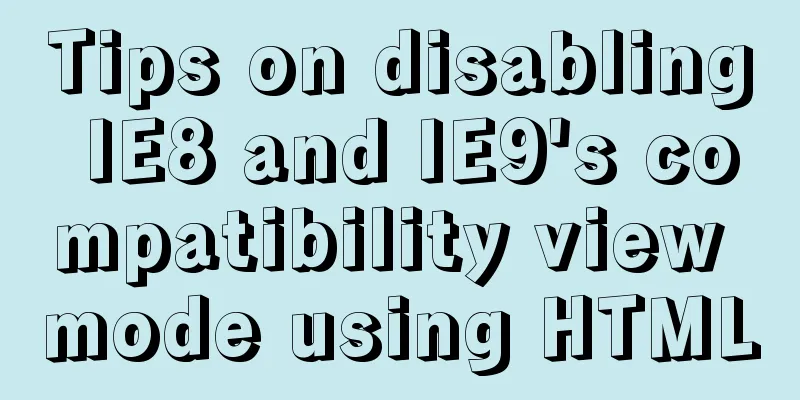Tips on disabling IE8 and IE9's compatibility view mode using HTML

|
Starting from IE 8, IE added a compatibility mode, which will render with a lower version of IE when enabled. But sometimes this will cause problems with the web page, so we usually add the following code in HTML to make IE use a fixed rendering mode: Copy code The code is as follows:<meta http-equiv="X-UA-Compatible" content="IE=8"> <!--Render in IE8 mode--> <meta http-equiv="X-UA-Compatible" content="IE=7"> <!-- Render in IE7 mode --> But I encountered a situation where the page can only be displayed normally in IE8 if the compatibility mode is not used. However, if the mode is set to IE8, CSS3 will become invalid in IE9. It seems that I need to disable compatibility mode for IE8 and IE9 respectively. What should I do? You can determine the browser version in the background. If it is IE8, output content="IE=8", and if it is IE9, output content="IE=9". But this is not possible with HTML. In fact, you can simply use the following code to achieve this: Copy code The code is as follows:<meta http-equiv="X-UA-Compatible" content="IE=9; IE=8; IE=7; IE=EDGE"> |
<<: What does it mean to add a question mark (?) after the CSS link address?
>>: The website is grayed out. Compatible code including images supports all browsers
Recommend
CSS style writing order and naming conventions and precautions
The significance of writing order Reduce browser ...
Detailed explanation of Strict mode in JavaScript
Table of contents Introduction Using Strict mode ...
JavaScript implements the drag slider puzzle verification function (html5, canvas)
introduction: Slider drag verification is now use...
More than 300 lines of CSS code to achieve the explosive special effects of WeChat 8.0
A major feature of the WeChat 8.0 update is the s...
Common scenarios and avoidance methods for index failure in MySQL
Preface I have read many similar articles before,...
What codes should I master when learning web page design?
This article introduces in detail some of the tech...
Example of using Nginx reverse proxy to go-fastdfs
background go-fastdfs is a distributed file syste...
Small paging design
Let our users choose whether to move forward or ba...
JavaScript destructuring assignment detailed explanation
Table of contents concept Array Destructuring Dec...
Let's talk in detail about the props attributes of components in Vue
Table of contents Question 1: How are props used ...
JavaScript to achieve a simple countdown effect
This article example shares the specific code of ...
Teach you how to get the pointer position in javascript
The method of obtaining the position of the point...
Initial summary of the beginner's website building tutorial
After writing these six articles, I started to fee...
Sample code for html list box, text field, and file field
Drop-down box, text field, file field The upper p...
How to run top command in batch mode
top command is the best command that everyone is ...









